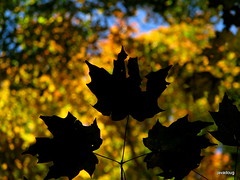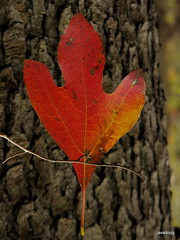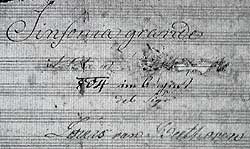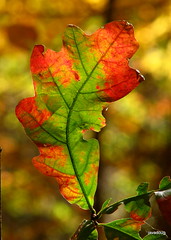A few weeks ago I blogged that Beethoven represented a singularity in as much as the composers before and since were merely prelude and postscript. Yet I'm doing a huge injustice to many other great composers. By leapfrogging Haydn and Mozart, both with a wealth of not just pleasant, but uniquely genius compositions in their own right, I've forgotten two of the best in the classical form. Tonight I was able to hear them both.
Before the concert in the lobby I recognized a musician that I thought I saw playing the violin several weeks before. I introduced myself, and found out that I was wasn't imagining, she was a 'sub' and had played during the Gala. How is it that we as humans can often recognize faces, or to transcribe the metaphor, music? Remembering the name is not quite as easy as remembering the selection I'm listening to, or to the face of a person I know I've seen before - she said her name is Rachel if I remember correctly - I hope she's able to sub again soon. I was told I was the first to recognize her in public.
In the concert hall, Leonard Slatkin enters, bows, and immediately begins the Haydn Symphony 67. Haydn's music is joyful, playful, tuneful, creative, dramatic, melodic, subtle and forceful without overpowering. In the first movement the double bass adds harmony. The second movement pushes deep timbers with the strings, and then we're treated to a two part counterpoint with the strings, left and right, then backdrop with the woodwinds. The bass and cello join in to complement a phrase. A slow ending exhibits a bit of murmur and mirth -- the entire string section is directed to play
col legno dell'arco (tapping the strings with the back of the bow). The effect is quite creative - I enjoyed the sound it produced.
The 3rd movement embeds a zingy interlude where the principle string player left and right of the conductor play enchanting melody back and forth and together. Conductor Slatkin, in a move hardly seen in a classical concert, exits the podium, turns, and tips both violin soloists with a bill while they are playing, to great laughter and applause from the audience. The final movement again has the 1st violin solo and the 2nd violin accompany, but it's a trio, the 1st cello joins in.
The next selection by American composer
Alan Hovhaness, his Symphony No. 2, "Mysterious Mountain," was the new piece for me this evening. Having never heard this before, I came with great anticipation and an open mind. Leonard Slatkin, who often conducts American music, introduced the music by indicating some of the elements, including a form of dissonance not usual for the harp, double bass and
celesta (The sound of the celesta is similar to that of the glockenspiel, but with a much softer and more subtle timbre).

From the start this music did not disappoint. It began with a gentle yet profound kind of resonance, probably due to the celesta, with bass playing pizzicati. From there the movement developed into a grand uplifting experience with surreal sounds seemingly always rising. The harmonies would buoyantly build a line, and just before that line would let up, the dissonant sounds we were told to listen for would chime in, adding the kind of rhythmic effect we might encounter in any walk with nature. The second movement began with a faster flowing pace. Soon it was rapid, racing with various sections, as if a multitude of leaves had just fallen from a tree, and were curried by the wind, then abating, curling with repetitions to and fro. The gale intensifies with the horns enraging and then the movement comes to an abrupt halt. The 3rd brought a slow struggle, much more dramatic with tension building. A final adagio could represent the final ascent to the top of the mysterious mountain - somewhat reminiscent of the 1st with the strings then woodwinds following with voices recanting the vivid view along the way, looking out and ever upwards, and now as we ascend the entire orchestra joins to embellish a grand finale as we have arrived at the peak - "
the meeting place between the mundane and the spiritual worlds."
All

week I've been looking forward to listen to James Galway play Mozart's Flute Concerto No. 2 this weekend at Heinz Hall. But what was a surprise to me was that he also performs with the Pittsburgh Symphony Orchestra in Bizet's Carmen Fantasy.
After intermission Sir James Galway enters the stage, bows humbly, and with the direction of Leonard Slatkin, conductor, begins. He's wearing a marvelous jacket of gold and black with red handkerchief and tie with a beige vest - he looks great. How can I adequately describe his playing? What I especially like is the trilling/lilting quality of the tones from his flute especially with the low notes, when held for a time. It's entertaining to watch him with finger movements darting up and down the scale with racing notes, then back to the sublime low frequencies as the orchestra accents. I've heard this concerto by Mozart many times, but here live with solos by Galway, it's like never before. Tte slow movement now absorbs special ebullient quality like I've never realized before. The 3rd is instantly recognizable - a spirited and sprightly razzle dazzle to conclude.
Next up: Bizet Carmen Fantasy with solo flute. Now this is the Pièce de résistance. What an interesting beginning - and on this journey we've probably encountered before, we hear a beautiful rendition with James Galway and the PSO.
Finally we are treated to three encore pieces which might be expected, and Galway calls them 3 Lollipops (after
Thomas_Beecham).
- Brian Boru's March - a beautiful tune!
- Danny Boy
- Badinerie by Johann Sebastian Bach (Galway said "Johann Sebastian..." and the audience answered "Bach", then he said "Who?", again "Bach", then he said "You're definitely not at a football match" meaning the audience wasn't loud or enthusiastic enough)
Then we were treated to one more encore - the Bach Badinerie one more time, only really fast - in fact, Slatkin exclaimed "See who can play this Bach piece faster!" - applause!


Flute Academy Flute Chorus - pre-concert music in the lobby.


 the end came a few Strauss selections with lots of fun - first Manfred Honeck indicates that there is an expression (paraphrasing) "in Germany it is said they work 350 days and are on holiday 15, but in Austria they work 15 days and are on holiday 350." This was the introduction to 'Auf Ferienreisen' (Holiday Trips) by Josef Strauss, where Mr. Bendix-Balgley strolls out in vacation garb, situates a beach chair, opens a few beers, gives a few to the orchestra including the Maestro, and generally garners many laughs. Josef Strauss' 'Feuerfest Polka' comes next, with a real anvil, and the percussionist (help me with his name, he was great!) places a terrible towel on the beach chair, dons a pair of sunglasses, and does his percussion on the anvil while drinking beer. What a great time!
the end came a few Strauss selections with lots of fun - first Manfred Honeck indicates that there is an expression (paraphrasing) "in Germany it is said they work 350 days and are on holiday 15, but in Austria they work 15 days and are on holiday 350." This was the introduction to 'Auf Ferienreisen' (Holiday Trips) by Josef Strauss, where Mr. Bendix-Balgley strolls out in vacation garb, situates a beach chair, opens a few beers, gives a few to the orchestra including the Maestro, and generally garners many laughs. Josef Strauss' 'Feuerfest Polka' comes next, with a real anvil, and the percussionist (help me with his name, he was great!) places a terrible towel on the beach chair, dons a pair of sunglasses, and does his percussion on the anvil while drinking beer. What a great time!



















 No. 5
No. 5 No. 6a
No. 6a No. 6b
No. 6b No. 8 Paris catacombs (with the figures of V. A. Hartmann, V. A. Kenel, and a guide, holding a lantern)
No. 8 Paris catacombs (with the figures of V. A. Hartmann, V. A. Kenel, and a guide, holding a lantern) No. 9 The hut of Baba-Yaga on hen's legs–clock in the Russian Style
No. 9 The hut of Baba-Yaga on hen's legs–clock in the Russian Style No. 10 Project for a city gate in Kiev–main façade
No. 10 Project for a city gate in Kiev–main façade





















